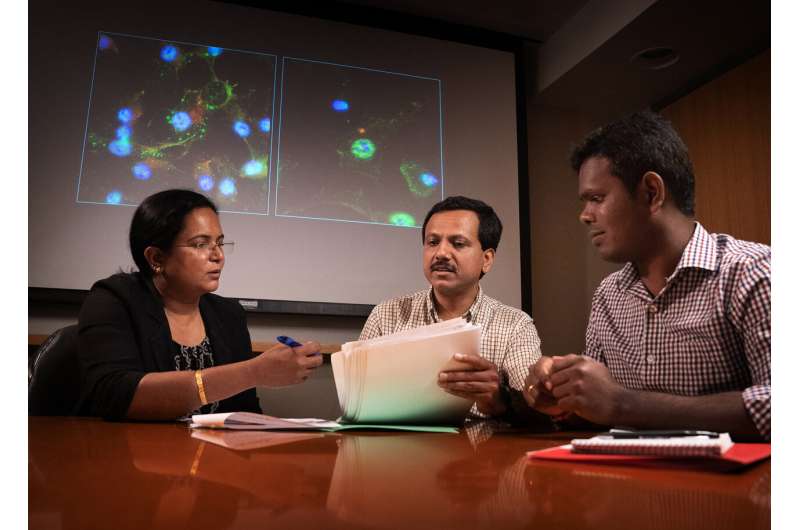Meet the molecule that helps stressed cells decide between life and death

St. Jude Children's Research Hospital scientists have identified a molecule that plays a pivotal role in determining the fate of cells under stress, much like a Roman emperor deciding the fate of gladiators in the coliseum. The findings appear today in the journal Nature and suggest a possible new approach for treatment of autoinflammatory and other diseases.
The molecule is DDX3X, an enzyme that when mutated is involved in a variety of cancers, such as those of the breast, lung and brain, including medulloblastoma, the most common malignant pediatric brain tumor. DDX3X mutations are also associated with DDX3X syndrome, which is characterized by intellectual disabilities, seizures, autism, poor muscle tone and slower physical development.
Researchers have determined that DDX3X also sits at the crossroads between life and death in stressed cells. The molecule helps regulate the innate immune response, which is part of the immune system's first-responder system. Investigators reported evidence that the availability of DDX3X influences how cells interpret and respond to various stressors with measures meant to ensure cell survival or cell death.
"The findings make DDX3X an attractive target for designing drugs that modify the stress response and restore balance to prevent chronic inflammation and other diseases," said corresponding author Thirumala-Devi Kanneganti, Ph.D., a member of the St. Jude Department of Immunology. The co-corresponding author is Richard Gilbertson, M.D., Ph.D., formerly of St. Jude and now of Cancer Research UK Cambridge Institute.
Stress response
Investigators knew stressed cells needed DDX3X to form membrane-less compartments called stress granules. Stress granules are essential for cell survival. In this study, scientists showed DDX3X was also critical for formation of another membrane-less compartment that led to cell death via a programmed inflammatory cell death pathway.
"The results represent a major advance in understanding innate immunity and the cell-stress response, demonstrating that DDX3X-mediated interplay between two membrane-less compartments allows for different cell fates," Kanneganti said.
Inflammation
Kanneganti's laboratory has a long-standing research interest in the inflammatory cell stress response, particularly a multi-protein complex called the NLRP3 inflammasome.
Infections and other stressors activate NLRP3. Activation leads to formation of a membrane-less compartment in cells and secretion of molecules called cytokines that promote inflammation. The process also drives the inflammatory cell death pathway called pyroptosis. Over-activation of the NLRP3 inflammasome gives rise to cancers and autoinflammatory diseases such as atherosclerosis and type-2 diabetes.
Because cells also respond to stress with formation of stress granules, Kanneganti and her colleagues were curious about a possible connection between inflammasome activation and stress granule assembly.
The search led to DDX3X.
The evidence
Working first in white blood cells called macrophages in the laboratory and then in mice with myeloid cells that lacked the Ddx3x gene, researchers reported for the first time that DDX3X interacts with NLRP3 and promotes inflammasome activation.
Further research revealed that stress granule formation inhibited the NLRP3 inflammasome by sequestering DDX3X. That limited the molecule's availability for NLRP3 inflammasome activation and function. Pro-inflammatory cytokine production declined along with cell death via pyroptosis.
"The findings suggest that competition for DDX3X between stress granules formation and NLRP3 inflammasome activation allows macrophages to interpret stress signals and choose their fate," said Parimal Samir, Ph.D., of St. Jude.
Added Kesavardhana Sannula, Ph.D., of St. Jude: "Our model is that formation of stress granules specifically inhibits the availability of DDX3X to activate the NLRP3 inflammasome, inhibiting the pyroptosis cell death pathway."
More information: Parimal Samir et al, DDX3X acts as a live-or-die checkpoint in stressed cells by regulating NLRP3 inflammasome, Nature (2019). DOI: 10.1038/s41586-019-1551-2

















